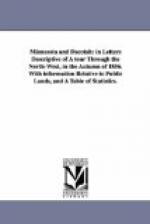Their old costume is still retained as a general thing. The blanket is still worn instead of coats. Sometimes the men wear leggins, but often go with their legs naked. A band is generally worn upon the head with some ornament upon it. A feather of the war eagle worn in the head-band of a brave, denotes that he has taken the scalp of an enemy or performed some rare feat of daring. An Indian does not consider himself in full dress without his war hatchet or weapons. I meet many with long-stemmed pipes, which are also regarded as an ornamental part of dress. They appear pleased to have anything worn about them attract attention. They are of good size, taller than the Winnebagoes, and of much lighter complexion than tribes living five hundred miles further south. Herein the philosopher on the cooking of men is confirmed. Their hair is black, long, and straight; and some are really good-looking. There are but few who still paint. Those in mourning paint their faces black. What I have seen of their houses raises high hopes of their advancement in civilization. We can now begin to lay aside the word lodge and say house. Over a year ago, Mr. Herriman promised every one a good cooking stove who would build himself a comfortable house. This promise had a good effect, for several houses were built. But the want of windows and several other conveniences, which are proper fixtures, gives their dwellings a desolate appearance to one who looks to a higher standard of comfort. Of course I saw a few of the men at the store (for there is a store at the agency), spending their time, as too many white men do in country villages. Eight miles beyond the agency, on Gull Lake, is a mission.




